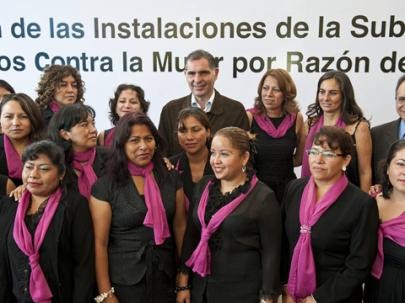
On a sunny afternoon in 2012, Ileana Araceli Hernandez, deputy attorney general for Mexico's state of Oaxaca, was busy studying the documents spread over a large table in her office. But this was not her usual bundle of legal papers: They were large-scale architectural drawings mapping out the state’s first Women’s Justice Center.
“This will be the reception, and this will be where we look after victims of domestic violence,” explains Hernandez, running a finger over several details on the plans.
The center has been Hernandez’s dream ever since she went on a USAID-sponsored training trip to the state of Nuevo León in 2010. “That was the inspiration,” she says. “The experience made me realize exactly what we had to do here in Oaxaca. It gave me a glimpse of the future. If you don’t train, and if you don’t get to see what other people are doing, you are condemned to a life without innovation and to be trapped within the confines of what you already know.”
Hernandez is working to secure a judge for the center to provide rulings on divorce, financial settlements and custody of children. Within the reform framework, the Mexican Government and Oaxaca have invested about $1 million in infrastructure to establish the Women's Justice Center. The government hopes to start a nationwide trend of women’s centers with federal support from the Secretariat of Governance and the National Commission for the Prevention and Eradication of Violence against Women. USAID is helping to facilitate the expansion of women's centers by sharing experiences and developing model operational manuals.
Oaxaca desperately needs this center. The acutely poor and mountainous state on the Pacific coast is improving in terms of security, with homicide rates steadily decreasing over the last decade. But Oaxaca still suffers from issues such as an 81.7 percent impunity rate for murder, and an unreported crime rate of 83.7 percent.
Yet, the Special Attorney General's Office for Crimes Against Women has started to take important steps forward. Thanks to the USAID-sponsored trips, Hernandez and her team established the office in 2011, which they expanded from a smaller unit within the state office. In 2012, the office handled more than 2,000 cases—many of them involving women in the throes of despair following a violent crime.
One of them was 20-year-old Rosa*, who arrived at the office a few days after her uncle brutally raped her. Frightened and tormented by feelings of humiliation, Rosa received psychological support and legal assistance at the office free of charge. “I couldn’t speak, I felt so ashamed and I didn’t want anyone to see me,” she recalls. “But here, I got the help I needed. I feel I am no longer alone.” The office staff provided support to Rosa for several months.
None of that professional help would have been possible without USAID, which trained all of Hernandez’s staff through a series of seminars and workshops. The training taught staff about the rights of victims under the new system, and how to provide victims with legal, employment and psychological assistance.
USAID's work in this area is part of the Justice and Security Program that began in 2009. The program provides advice on the development of new criminal justice legislation, trains justice system actors on their roles in the new system, and works with civil society organizations to foster criminal justice reform.
* Last name withheld for privacy reasons.







Comment
Make a general inquiry or suggest an improvement.